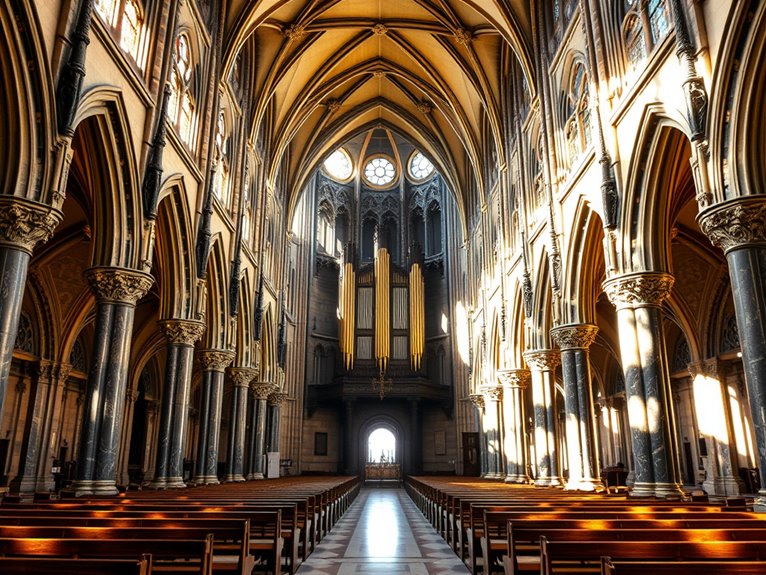
9 Stunning Church Interiors in Paris Beyond Notre-Dame
While Notre-Dame undergoes restoration, I'll show you nine equally magnificent church interiors across Paris. From Saint-Eustache's towering Gothic vaults and France's largest pipe organ to Sainte-Chapelle's dazzling 13th-century stained glass windows, each church offers unique architectural wonders. You'll discover Saint-Sulpice's famous Delacroix murals, Saint-Étienne-du-Mont's intricate Renaissance stonework, and the oldest columns in Paris at Saint-Germain-des-Prés. Let's explore these hidden religious treasures that rival Notre-Dame's splendor!
Saint-Eustache: Gothic Grandeur in Les Halles
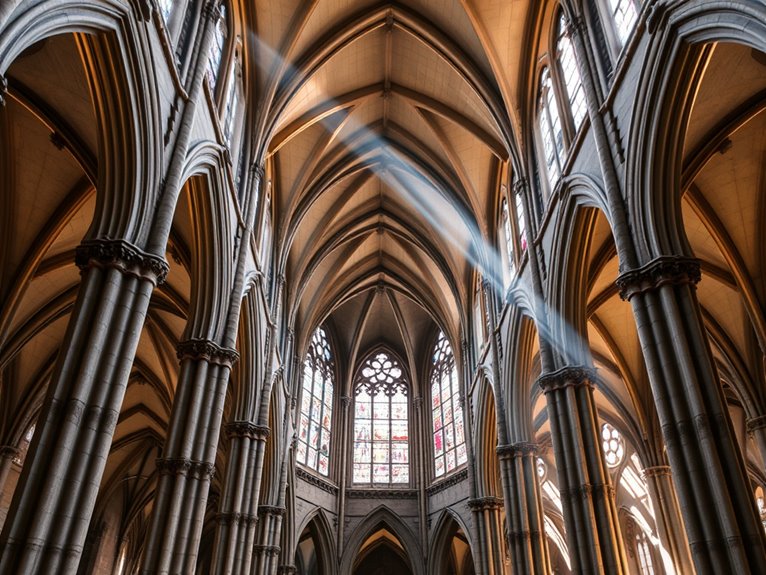
Church Interiors in Paris: Saint-Eustache
Gothic Grandeur in Les Halles
Standing majestically in the heart of Paris's former marketplace district, Saint-Eustache Church represents one of the finest examples of late Gothic architecture blended with Renaissance elements. This architectural marvel, often overshadowed by its famous neighbor Notre-Dame, offers visitors an equally impressive interior that spans 105 meters in length, boasting soaring vaults that reach heights of 33.46 meters.
The church's interior presents a spectacular fusion of medieval and classical design elements, housing remarkable artworks, the largest pipe organ in France, and acoustics that have made it a premier venue for classical concerts. From its intricate stone tracery to the play of light through its magnificent stained glass windows, Saint-Eustache provides an immersive experience in French ecclesiastical architecture spanning multiple artistic periods.
Quick Facts:
- Visiting Hours: 9:30 AM – 7:00 PM daily
- Entry Fee: Free admission
- Best Time to Visit: Weekday mornings or during organ recitals (Sundays at 5:30 PM)
- Photography: Allowed without flash
- Guided Tours: Available on Sundays at 3:00 PM
- Location: 2 Rue du Jour, 75001 Paris
- Accessibility: Wheelchair accessible through side entrance
Notable Interior Features:
The Great Organ
This masterpiece of French organ craftsmanship contains 8,000 pipes and was restored in 1989. The organ fills the vast space with extraordinary sound during regular concerts and Sunday masses. Visitors can climb to the organ loft during specific guided tours, offering a rare behind-the-scenes perspective of this magnificent instrument.
Keith Haring Chapel
A unique modern addition, the chapel features one of Keith Haring's last works – a striking bronze triptych that represents life, death, and resurrection. This unexpected contemporary element provides a fascinating contrast to the church's traditional architecture and demonstrates its ongoing artistic evolution.
Rubens' "Pilgrims of Emmaus"
This masterpiece painting hangs in the south transept, showcasing remarkable use of light and shadow. Best viewed in morning light when sunbeams illuminate the canvas through nearby windows, creating an almost three-dimensional effect.
Pro Tips:
For the most atmospheric experience, visit during the late afternoon when sunlight streams through the western rose window, creating spectacular light effects throughout the nave. Organ recitals on Sundays provide not only musical enjoyment but also the perfect opportunity to appreciate the church's acclaimed acoustics. Consider timing your visit to coincide with these performances, arriving 30 minutes early to secure a good viewing position.
Practical Advice:
While the church is generally quiet, its location near Les Halles shopping center means the surrounding area can be quite busy. Enter through the less-crowded north door for a more peaceful experience. The church offers printed guides in multiple languages at the entrance – these provide valuable context for the artwork and architectural features throughout the building. Remember that despite being a tourist attraction, Saint-Eustache remains an active place of worship, so dress respectfully and maintain appropriate silence during services.
Saint-Étienne-du-Mont: A Marriage of Gothic and Renaissance
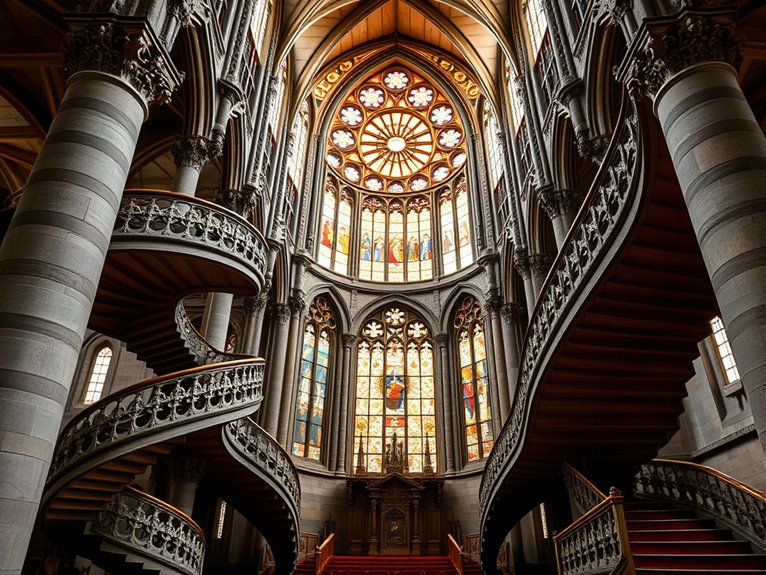
Located in the Latin Quarter of Paris, Saint-Étienne-du-Mont stands as a remarkable demonstration to the architectural transformation between Gothic and Renaissance styles. This lesser-known church, nestled behind the Panthéon, showcases one of the most unique architectural fusions in Paris, featuring the city's only surviving rood screen (jubé) and housing the shrine of Saint Geneviève, Paris's patron saint.
The church's distinctive character emerges from its harmonious blend of late Gothic architecture with early Renaissance elements, creating an interior that feels both soaring and intimate. Visitors are treated to an architectural symphony of spiral staircases, delicate stone tracery, and magnificent 16th-century stained glass windows that illuminate the space with ethereal light.
Quick Facts:
- Opening Hours: 8:30 AM – 7:45 PM (Monday-Saturday), 8:30 AM – 8:45 PM (Sunday)
- Best Visiting Time: Early morning or late afternoon for peak light through stained glass
- Photography: Allowed without flash; tripods require permission
- Admission: Free
- Guided Tours: Available on Sundays after mass (in French)
- Accessibility: Limited; several steps at entrance
Key Features:
The Rood Screen (Jubé)
This extraordinary carved stone bridge, completed in 1545, is the only surviving example in Paris. The delicate spiral staircases on either side create a lace-like effect, demonstrating the pinnacle of French stonework craftsmanship. The screen can be viewed during regular church hours, but the best photos are captured during morning light.
Insider tip: Position yourself at the back of the nave for the most dramatic view of the screen against the choir's stained glass windows.
Saint Geneviève's Shrine
The stone sarcophagus containing Saint Geneviève's relics draws pilgrims year-round. The shrine's location in the south chapel features intricate carved details and votive candles, creating an intimate atmosphere for prayer and reflection.
Insider tip: Visit during the annual feast of Saint Geneviève (January 3) to witness special ceremonies and processions.
Renaissance Stained Glass
The church houses an exceptional collection of 16th and 17th-century stained glass windows, with particularly notable examples in the ambulatory. The windows combine religious narratives with Renaissance artistic techniques.
Insider tip: Visit on sunny afternoons when the western light creates spectacular color projections on the church's columns.
Pro Tips:
The best experience of Saint-Étienne-du-Mont comes from timing your visit thoughtfully. Arrive just as it opens to have the space largely to yourself, or visit during organ concerts (typically Sunday afternoons) to experience the church's remarkable acoustics. Photography enthusiasts should visit during winter months when the sun's angle creates dramatic light effects through the stained glass.
Practical Advice:
While the church is easily accessible from the Luxembourg RER station, combining your visit with the nearby Panthéon and other Latin Quarter attractions makes for an efficient itinerary. Be mindful of ongoing services, particularly during weekends and religious holidays. The church maintains silence rules, so bring headphones if you plan to use audio guides. Consider bringing a small pair of binoculars to appreciate the detailed stonework and stained glass from ground level.
Saint-Sulpice: The Grand Rival of Notre-Dame
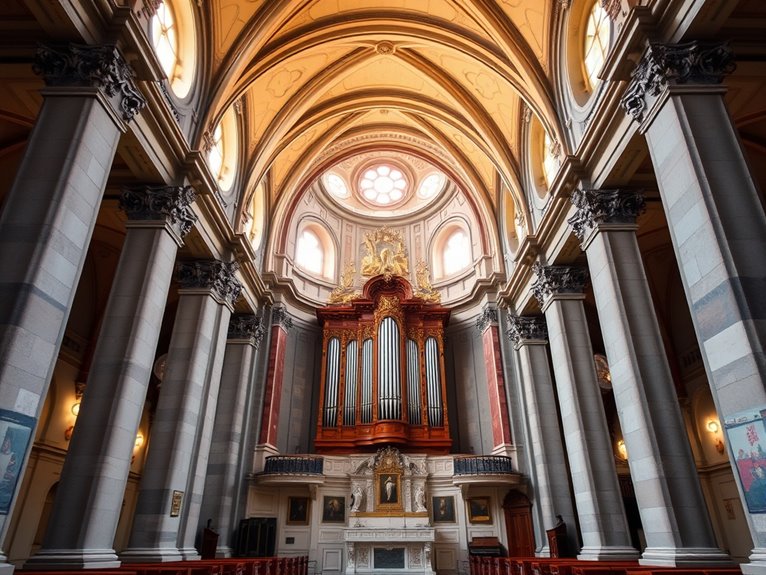
Standing majestically in the heart of Paris's 6th arrondissement, Saint-Sulpice presents itself as a magnificent indication of French ecclesiastical architecture, second only to Notre-Dame in size among Paris's churches. This colossal structure, with its mismatched towers and remarkable fusion of classical and baroque elements, has captivated visitors for centuries, earning its reputation as one of Paris's most significant religious monuments.
Beyond its architectural grandeur, Saint-Sulpice gained additional fame through Dan Brown's "The Da Vinci Code," though the true historical and artistic significance of this church far outweighs its fictional associations. Visitors can explore everything from Delacroix's stunning murals to the world-famous Cavaillé-Coll organ, while the church's unique gnomon astronomical marking device offers a fascinating glimpse into 18th-century scientific innovation.
Quick Facts:
- Opening Hours: 7:30 AM – 7:30 PM daily
- Best Visiting Times: Early morning or late afternoon on weekdays
- Photography: Allowed without flash; tripods require permission
- Admission: Free (organ demonstrations have separate fees)
- Mass Schedule: Multiple daily services
- Accessibility: Wheelchair accessible via side entrance
- Guided Tours: Available in multiple languages (pre-booking required)
The Great Organ
The church houses one of the world's finest pipe organs, built by Aristide Cavaillé-Coll in 1862. Regular recitals occur on Sundays after the 10:30 AM Mass. The organ has been played by numerous celebrated musicians, including Charles-Marie Widor, who served as organist for 63 years. Insider tip: Stand in the center of the nave during organ performances for ideal acoustics.
Delacroix's Murals
The Chapel of the Holy Angels features three magnificent murals by Eugène Delacroix, painted between 1855 and 1861. These masterpieces depict scenes of spiritual struggle, including "Jacob Wrestling with the Angel." Visit between 10 AM and 2 PM for the best natural lighting to appreciate the artwork's subtle details.
The Gnomon
A unique astronomical instrument, the gnomon consists of a brass line running north-south across the church floor, with an obelisk in the transept. This scientific tool was used to determine the exact date of Easter and track the sun's movement. Visit during sunny days around noon to witness the sun's ray hitting the brass line.
Pro Tips:
To truly appreciate Saint-Sulpice's grandeur, visit during different times of day to experience how the light transforms the interior. The best photographs can be taken during early morning hours when sunlight streams through the eastern windows. For organ enthusiasts, arrive 30 minutes before Sunday recitals to secure a prime listening position near the center of the church.
Practical Advice:
While Saint-Sulpice welcomes visitors throughout the day, remember it's an active place of worship. Dress modestly and maintain respectful silence, particularly during services. The church's location in the fashionable Saint-Germain-des-Prés neighborhood makes it easy to combine your visit with exploration of nearby cafés, boutiques, and the Luxembourg Gardens. Consider purchasing a guidebook at the church entrance for detailed information about the architectural elements and artwork.
Saint-Germain-des-Prés: Paris's Oldest Church
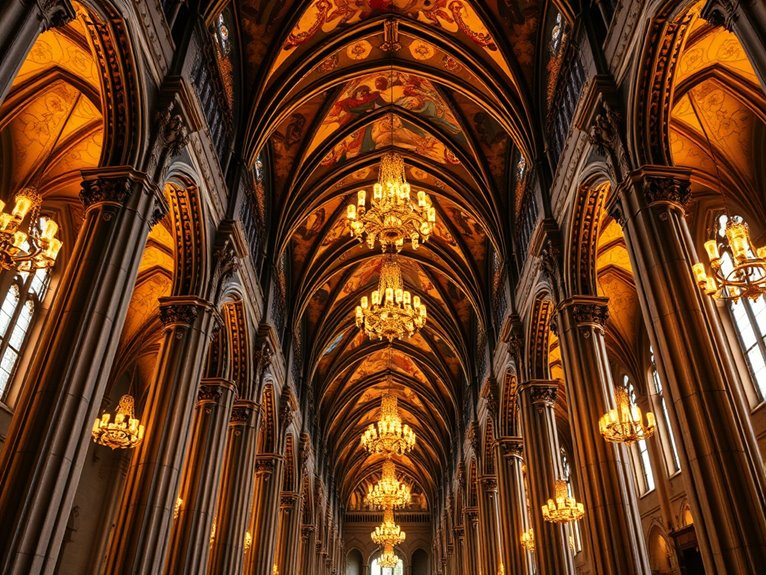
Church Interiors in Paris: Saint-Germain-des-Prés
The Oldest Church in Paris
Standing as Paris's oldest church, Saint-Germain-des-Prés has witnessed over 1,400 years of history within its ancient walls. Founded in 543 AD, this remarkable Romanesque structure has survived Vikings, revolutions, and modernization, emerging as a demonstration of the city's enduring spiritual and architectural heritage. The church's weathered stone exterior belies an interior that showcases some of the finest medieval religious art and architecture in France.
Visitors to Saint-Germain-des-Prés step into a world where Romanesque and Gothic styles merge seamlessly, creating an atmosphere of profound historical significance. The church's recently restored frescoes, dating from the 19th century, illuminate the nave with vibrant colors, while ancient capitals and columns tell stories of medieval craftsmanship and religious devotion.
Quick Facts:
- Opening Hours: Daily 8:00 AM – 7:45 PM
- Mass Times: Weekdays 8:00 AM, 12:15 PM, and 7:00 PM; Sundays 9:00 AM, 11:00 AM, 7:00 PM
- Photography: Allowed without flash
- Admission: Free (donations appreciated)
- Best Visiting Time: Early morning or late afternoon for ideal lighting
- Guided Tours: Available on Tuesdays and Thursdays at 3:00 PM (15€)
Notable Features:
The Romanesque Nave
The church's nave represents one of the finest examples of Romanesque architecture in Paris. Original 11th-century capitals feature intricate biblical scenes and mythological creatures, while restored polychrome paintings create a stunning visual experience. Look for the unique capital depicting the "Martyrdom of Saint Vincent," rarely found in other Parisian churches.
The Medieval Choir
Recently restored to its original glory, the choir area showcases remarkable Gothic elements blended with Romanesque features. The space houses some of the oldest stone columns in Paris, dating to the 6th century. Insider tip: Look for the hidden mason's marks on the column bases, visible only during morning hours when sunlight streams through the eastern windows.
The Chapelle Saint-Symphorien
This intimate side chapel contains the tomb of René Descartes and features exceptional 19th-century murals by Hippolyte Flandrin. A lesser-known fact: The chapel's acoustics create a unique whisper effect similar to St. Paul's Cathedral in London.
Pro Tips:
Visit during organ recitals (typically Sundays after 11:00 AM Mass) to experience the church's magnificent 19th-century Cavaillé-Coll organ in action. For photography enthusiasts, arrive just before closing when the evening light creates dramatic effects through the clerestory windows. Consider timing your visit to coincide with classical music concerts, which are regularly held in the church and showcase its exceptional acoustics.
Practical Advice:
Located in the heart of Saint-Germain-des-Prés (Metro: Line 4), the church can get crowded during peak tourist seasons. Consider visiting during shoulder seasons (March-April or October-November) for a more contemplative experience. Remember to dress respectfully (covered shoulders and knees), and bring a small flashlight to better examine the detailed carvings and artwork in darker corners. The church offers excellent printed guides in multiple languages at the entrance, which provide detailed information about the historical and architectural significance of various features.
Sainte-Chapelle: A Medieval Jewel Box of Light
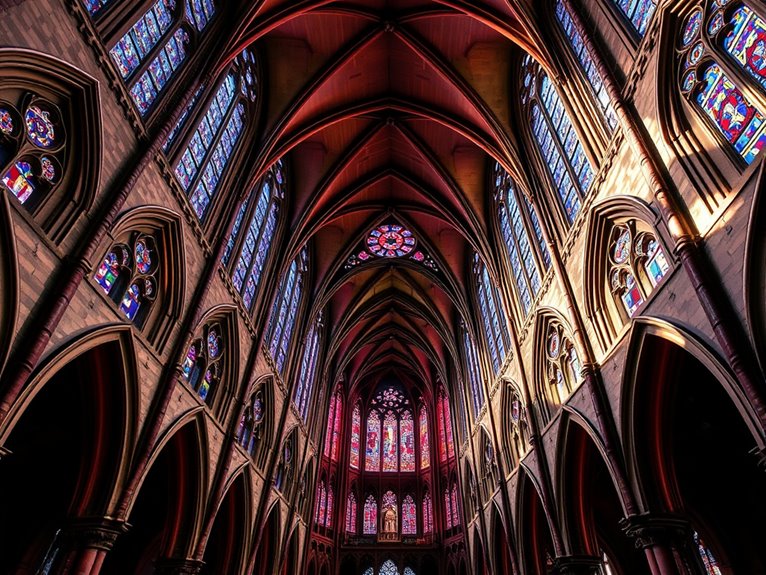
Standing within the Palais de la Cité on Île de la Cité, Sainte-Chapelle represents the peak of High Gothic architecture and medieval craftsmanship. Built in just seven years (1242-1248) under King Louis IX to house precious Christian relics, this royal chapel has survived centuries of history to emerge as one of Paris's most breathtaking architectural treasures.
The chapel's defining feature is its spectacular display of 13th-century stained glass windows, encompassing 15 windows that soar 49 feet high and contain 1,113 biblical scenes. The effect of sunlight streaming through these jewel-toned panels transforms the upper chapel into an ethereal space that demonstrates why Sainte-Chapelle is often described as "heaven on earth."
Quick Facts:
- Best visiting hours: 9:00 AM – 5:00 PM (October to March), 9:00 AM – 7:00 PM (April to September)
- Admission: €11.50 for adults, free for under 18
- Photography: Allowed without flash; tripods require special permission
- Wait times: 30-60 minutes during peak season
- Audio guides available in 8 languages
- Combined ticket available with Conciergerie
Upper Chapel:
The upper chapel represents the main attraction, featuring 6,458 square feet of stained glass windows depicting 1,113 scenes from the Old and New scriptures. The glass panels are arranged in a specific narrative sequence, telling biblical stories from Genesis to the Resurrection. The space features a star-studded vaulted ceiling and delicate architectural details that complement the windows' radiance. Insider tip: The risen sun creates different effects throughout the day, with prime viewing between 10 AM and 2 PM.
Lower Chapel:
Often overlooked, the lower chapel served the palace staff and features a lower, vaulted ceiling decorated with fleur-de-lis patterns and painted columns. The intimate space contains the oldest wall painting in Paris, dating to the 13th century. Insider tip: The lower chapel offers excellent photo opportunities without the crowds of the upper level.
Pro Tips:
Visit on a sunny day to experience the full glory of the stained glass, but avoid Sundays when mass services may restrict access. For photographers, early morning visits provide the best natural light conditions with fewer visitors. Consider using the skip-the-line tickets available online, especially during peak tourist season (June-August).
Practical Advice:
Security screening is required for entry, so arrive with extra time. The chapel is accessed via a narrow spiral staircase, which may be challenging for visitors with mobility issues. Remember that this is an active religious site, so appropriate dress and respectful behavior are expected. During restoration work (ongoing until 2025), some sections may be temporarily obscured, but the chapel remains a must-see destination for its unparalleled beauty and historical significance.
Saint-Paul-Saint-Louis: Baroque Elegance in Le Marais
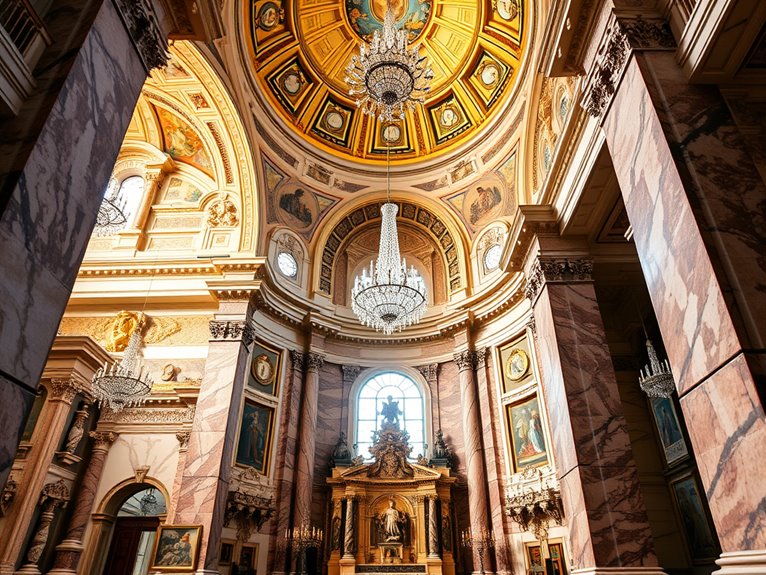
The Church of Saint-Paul-Saint-Louis stands as one of Paris's finest examples of Baroque religious architecture, bringing Italian Renaissance grandeur to the heart of Le Marais district. Built between 1627 and 1641 under Louis XIII's patronage, this magnificent church represents the first Jesuit church in Paris and marks a pivotal moment in French ecclesiastical architecture.
Visitors entering through its imposing facade are immediately struck by the soaring 57-meter-high dome, elaborate marble altarpiece, and stunning collection of Delacroix paintings. The church's unique blend of French and Italian Baroque styles, coupled with its historical significance as a symbol of Catholic renewal in 17th-century Paris, makes it an essential stop for both architecture enthusiasts and casual tourists exploring Le Marais.
Quick Facts:
- Opening Hours: 8:00 AM – 7:00 PM daily
- Best Visiting Time: Early morning or late afternoon for ideal lighting
- Photography: Allowed without flash
- Admission: Free
- Mass Schedule: Daily at 7:00 PM, additional times on Sundays
- Accessibility: Wheelchair accessible through side entrance
- Location: 99 Rue Saint-Antoine, 4th arrondissement
Interior Highlights
The central dome dominates the interior space, featuring masterful trompe l'oeil paintings that create an illusion of infinite height. The dome's architectural achievement is particularly remarkable as it was one of the first of its kind in Paris, inspiring later structures including Les Invalides.
Insider Tip: Look for the small side chapel dedicated to the Virgin Mary, which contains an original 17th-century wooden statue that survived the French Revolution.
The Delacroix Paintings
The church houses two significant Eugène Delacroix works: "Christ in the Garden of Olives" and "Christ on the Cross." These paintings, created in 1816, showcase the artist's mastery of dramatic religious scenes and represent rare examples of his early work.
Insider Tip: The best lighting for viewing these masterpieces occurs between 2:00 PM and 4:00 PM when sunlight streams through the clerestory windows.
Pro Tips:
To fully appreciate the church's architectural details and artwork, visit during weekday mornings when tourist numbers are lower. Consider bringing binoculars for a closer look at the dome's intricate paintings and architectural details. The acoustic properties of the space are exceptional – try to time your visit during choir practice (usually Wednesday evenings) or organ recitals (check the church bulletin for schedules).
Practical Advice:
While the church welcomes visitors throughout the day, respect for ongoing religious services is essential. Photography is permitted, but tripods require advance permission from the church office. The surrounding area offers excellent dining options in Le Marais, making it ideal to combine a visit with lunch or dinner exploration of the neighborhood. Street parking is limited, so public transportation (Metro Station Saint-Paul, Line 1) is recommended.
Val-de-Grâce: Royal Splendor and Golden Domes
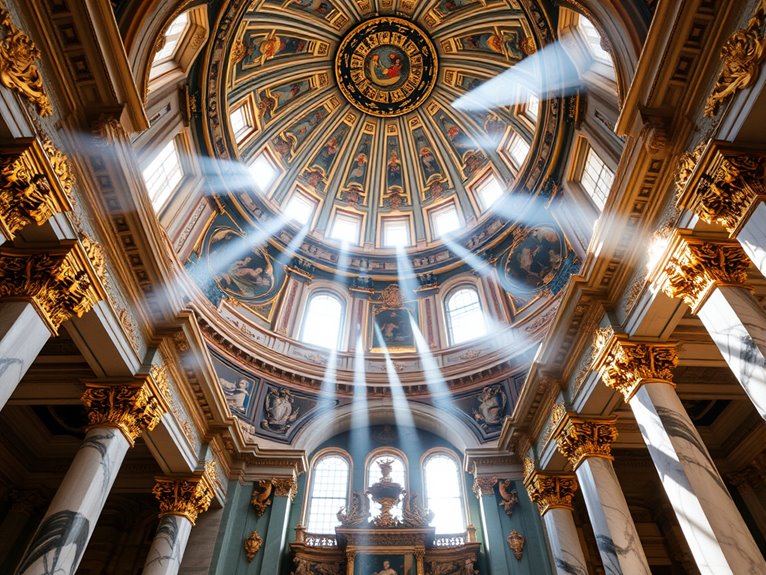
The Val-de-Grâce church stands as one of Paris's most magnificent examples of French Baroque architecture, commissioned by Queen Anne of Austria as a reflection of her gratitude for the birth of her son, the future Louis XIV. This 17th-century masterpiece showcases an extraordinary blend of religious devotion and royal grandeur, featuring one of the most impressive domed structures in Paris, second only to the Invalides in splendor.
Beyond its architectural significance, the church's interior holds remarkable artistic treasures, including Pierre Mignard's breathtaking dome fresco depicting "The Glory of Paradise," intricate marble work, and gilded decorations that reflect the height of French baroque craftsmanship. The site now serves both as a church and a museum, offering visitors an intimate glimpse into France's royal religious heritage.
Quick Facts:
- Opening Hours: Tuesday to Sunday, 12:00-6:00 PM
- Best Visiting Time: Early afternoon for best natural lighting
- Photography: Allowed without flash
- Admission: €7 for adults, free for under 18
- Guided Tours: Available in French (weekends only)
- Accessibility: Limited for mobility-impaired visitors
- Location: 5th arrondissement, near Luxembourg Gardens
The Central Dome
The church's crowning glory is its central dome, rising 55 meters high and adorned with Mignard's masterful fresco spanning 300 square meters. The dome's interior depicts over 200 figures in a swirling composition that creates an illusion of infinite height. Visit between 2:00-4:00 PM when sunlight streams through the windows, illuminating the golden details and bringing the fresco to vibrant life.
The Royal Chapel
Originally built as Queen Anne's private chapel, this intimate space features exquisite marble columns, gilded capitals, and intricate wood carvings. The chapel maintains its original 17th-century altar and houses several important religious relics. Insider tip: Look for the hidden monogram "A" (for Anne) integrated throughout the decorative elements.
The Monastery Cloister
Though less visited, the adjacent monastery cloister offers a peaceful retreat with its perfectly preserved architectural elements and medicinal garden. The space provides excellent photo opportunities and a quiet spot for contemplation away from tourist crowds.
Pro Tips:
Timing visits during weekday afternoons guarantees smaller crowds and better lighting conditions for photography. Consider combining a visit with the nearby Panthéon and Luxembourg Gardens for an extensive exploration of the 5th arrondissement's architectural treasures. For the best experience, bring binoculars to examine the dome's intricate details, as many subtle elements are difficult to appreciate from ground level.
Practical Advice:
The Val-de-Grâce complex includes a military medical museum, which requires separate admission but offers fascinating insights into French medical history. Plan at least 90 minutes for a thorough visit of the church interior, and note that some areas may be closed during religious services or special events. The RER B Luxembourg station provides the most convenient access, though several bus lines also serve the area.
Saint-Gervais-Saint-Protais: Three Centuries of Architecture
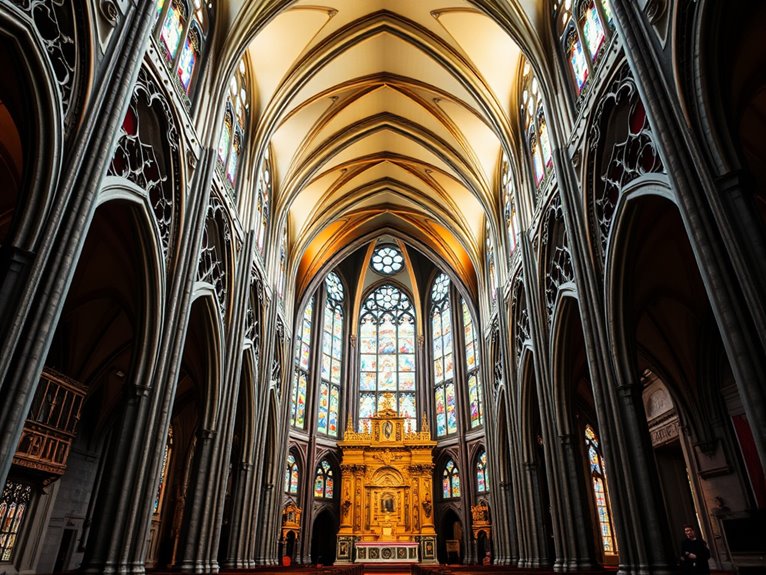
The Church of Saint-Gervais-Saint-Protais stands as a remarkable indication of the evolution of French religious architecture, showcasing an extraordinary blend of Gothic and Classical styles spanning three centuries. Located in the heart of Paris's Marais district, this architectural masterpiece offers visitors a unique opportunity to witness the shift of ecclesiastical design from the 13th to the 16th centuries.
The church's most striking feature is its west façade, completed in 1621, which represents the first example of a French Classical church front in Paris. Inside, the building reveals a fascinating journey through time, from its Gothic nave and choir to its Renaissance chapels, making it an essential stop for architecture enthusiasts and history buffs alike.
Quick Facts:
- Best visiting hours: 9:30 AM – 7:30 PM (Tuesday-Sunday)
- Photography: Allowed without flash
- Admission: Free
- Guided tours: Available on Saturdays (reservation required)
- Accessibility: Limited wheelchair access
- Best lighting conditions: Morning for stained glass windows
Key Architectural Features:
Gothic Nave (13th century)
The soaring Gothic nave represents the earliest part of the church, featuring pointed arches and ribbed vaults characteristic of the period. The nave's impressive height of 27 meters creates an atmosphere of vertical ascension typical of High Gothic architecture. Insider tip: Look for the medieval mason's marks still visible on some of the stone blocks.
Classical Façade (1621)
The revolutionary three-tiered façade by Salomon de Brosse introduced the superimposed classical orders (Doric, Ionic, and Corinthian) to French church architecture. The facade survived World War I bombing and remains remarkably intact. Insider tip: Visit during early morning hours when the rising sun illuminates the intricate stone carving details.
Renaissance Chapels
The side chapels, added during the 16th century, showcase the change to Renaissance style with their rounded arches and classical decoration. The Chapel of the Virgin, in particular, features extraordinary 16th-century stained glass windows. Insider tip: The chapel of Saint Denis contains hidden sculptural details only visible from certain angles.
Pro Tips:
The church's acoustics are particularly remarkable during the regular organ concerts held on Sunday afternoons. Position yourself in the center of the nave, about halfway down, for the best acoustic experience. The best photographs of the interior can be taken during morning hours when sunlight streams through the eastern windows, creating dramatic lighting effects across the Gothic vaulting.
Practical Advice:
While the church is open daily, visiting during mass times can limit access to certain areas. Plan your visit for mid-morning on weekdays to enjoy the space with fewer tourists and no service interruptions. The church occasionally closes for special events or maintenance, so checking the official website before visiting is recommended. Street parking is limited in the area, so using public transportation (Metro Station: Hôtel de Ville) is advised.
Saint-Séverin: Medieval Mystery in the Latin Quarter
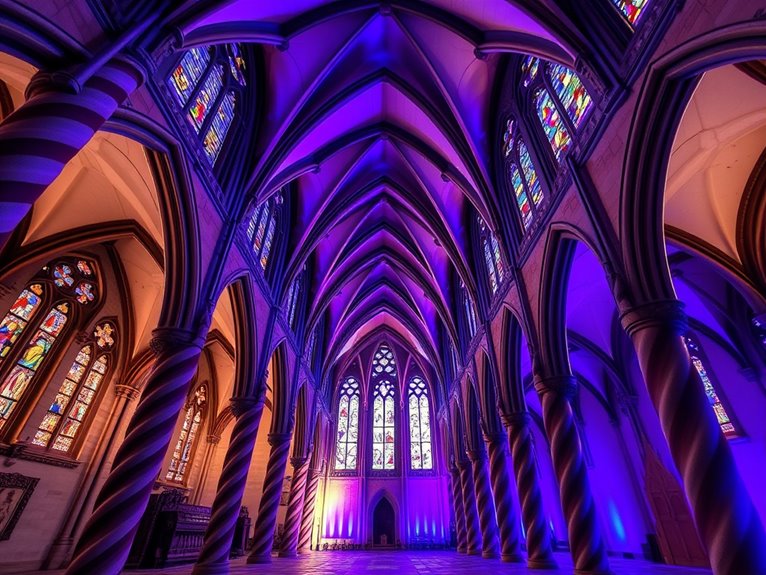
Tucked away in Paris's historic Latin Quarter, Saint-Séverin stands as one of the city's most enigmatic Gothic churches, offering visitors a mesmerizing glimpse into medieval architectural brilliance. Dating back to the 13th century, this church's unique double ambulatory and extraordinary spiral columns create an atmosphere that transports visitors through centuries of Parisian religious history.
The church's renowned palm tree vault and intricate stained glass windows, including both medieval masterpieces and contemporary additions, make it a must-visit destination for architecture enthusiasts and history buffs alike. While less crowded than Notre-Dame, Saint-Séverin delivers an equally authentic medieval church experience, complete with haunting gargoyles and flying buttresses that exemplify the finest Gothic craftsmanship.
Quick Facts:
- Opening Hours: 11:00-19:30 daily (except during services)
- Admission: Free
- Best Visiting Time: Early morning or late afternoon for ideal lighting
- Photography: Allowed without flash
- Accessibility: Limited; some steps at entrance
- Location: 3 Rue des Prêtres Saint-Séverin, 5th arrondissement
- Metro: Saint-Michel or Cluny-La Sorbonne
Notable Features:
The Double Ambulatory
A rare architectural feature that creates a mesmerizing circular path around the choir, the double ambulatory showcases extraordinary spiral columns that seem to twist toward heaven. This unique design element dates to the 15th century and represents the height of Gothic innovation.
Palm Tree Vault
The church's most celebrated architectural element, the palm tree vault, spreads its ribbed vaulting like palm fronds across the ceiling. Visit during morning hours when sunlight streams through the stained glass windows, creating an ethereal effect on the stone work.
Contemporary Stained Glass
While many windows retain their medieval character, the modern stained glass installations by Jean René Bazaine (1966) offer a striking contrast, demonstrating how contemporary art can harmonize with Gothic architecture. These windows are best viewed in late afternoon light.
Pro Tips:
Time your visit to coincide with one of the regular organ concerts, typically held on Sunday afternoons. The church's historical organ, dating from the 18th century, fills the space with magnificent sound that complements the architectural acoustics perfectly. Additionally, visit the church's exterior during the blue hour (just after sunset) when the gothic features create dramatic silhouettes against the darkening sky.
Practical Advice:
Combine your visit with exploration of the surrounding Latin Quarter, particularly the nearby Rue de la Huchette and Rue Saint-Jacques, which retain their medieval character. Consider downloading the church's official audio guide app before visiting, as on-site guides are limited. The church can get busy with student groups in the late morning, so early visits are recommended for a more contemplative experience. Remember to dress respectfully as this is an active place of worship.
